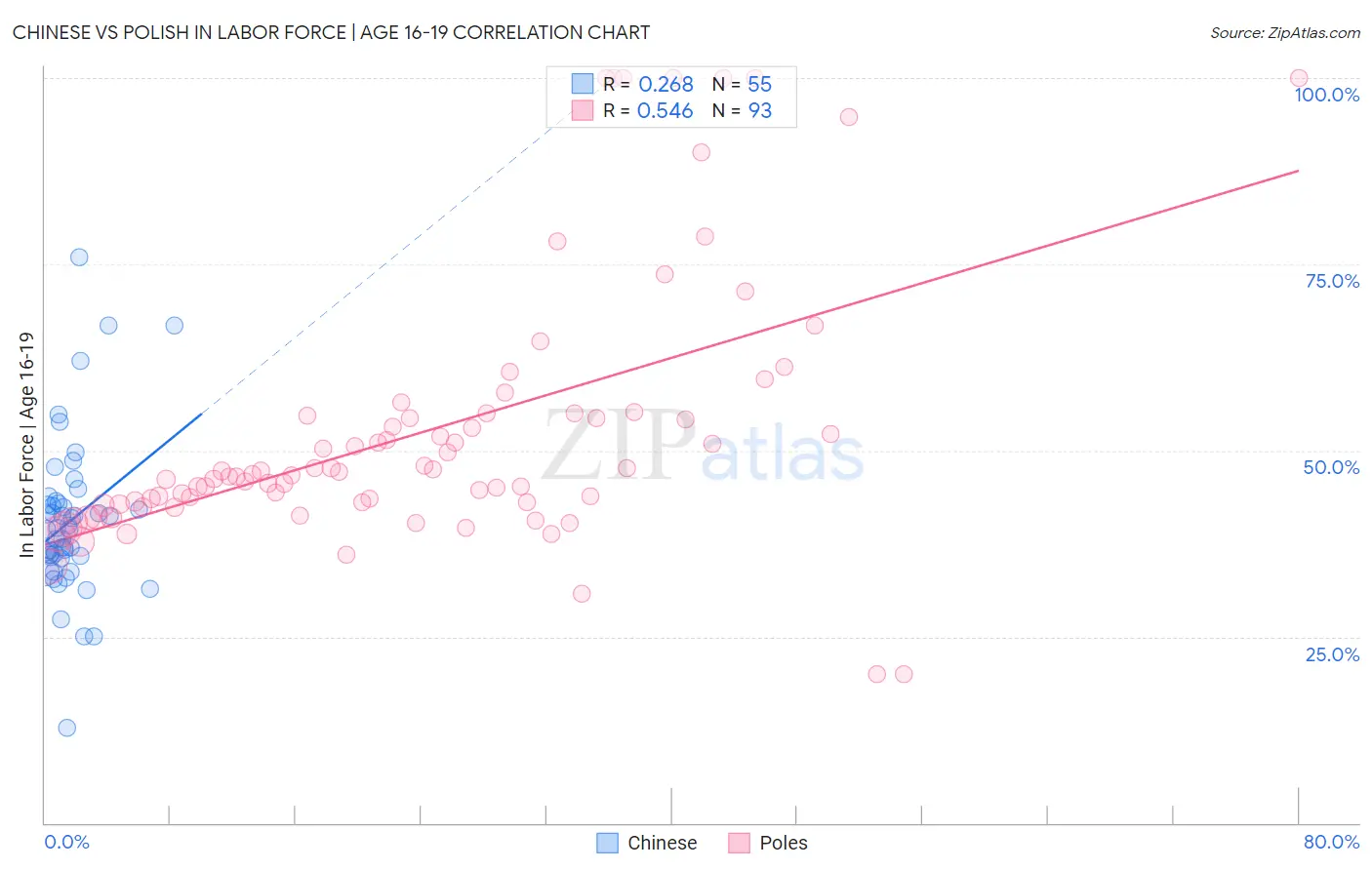Chinese vs Polish In Labor Force | Age 16-19
COMPARE
Chinese
Polish
In Labor Force | Age 16-19
In Labor Force | Age 16-19 Comparison
Chinese
Poles
38.6%
IN LABOR FORCE | AGE 16-19
98.8/ 100
METRIC RATING
107th/ 347
METRIC RANK
42.1%
IN LABOR FORCE | AGE 16-19
100.0/ 100
METRIC RATING
28th/ 347
METRIC RANK
Chinese vs Polish In Labor Force | Age 16-19 Correlation Chart
The statistical analysis conducted on geographies consisting of 64,804,450 people shows a weak positive correlation between the proportion of Chinese and labor force participation rate among population between the ages 16 and 19 in the United States with a correlation coefficient (R) of 0.268 and weighted average of 38.6%. Similarly, the statistical analysis conducted on geographies consisting of 556,989,344 people shows a substantial positive correlation between the proportion of Poles and labor force participation rate among population between the ages 16 and 19 in the United States with a correlation coefficient (R) of 0.546 and weighted average of 42.1%, a difference of 9.1%.

In Labor Force | Age 16-19 Correlation Summary
| Measurement | Chinese | Polish |
| Minimum | 12.8% | 20.0% |
| Maximum | 75.9% | 100.0% |
| Range | 63.1% | 80.0% |
| Mean | 40.5% | 52.6% |
| Median | 39.4% | 46.8% |
| Interquartile 25% (IQ1) | 35.7% | 42.9% |
| Interquartile 75% (IQ3) | 42.8% | 54.9% |
| Interquartile Range (IQR) | 7.1% | 12.0% |
| Standard Deviation (Sample) | 10.5% | 17.8% |
| Standard Deviation (Population) | 10.4% | 17.7% |
Similar Demographics by In Labor Force | Age 16-19
Demographics Similar to Chinese by In Labor Force | Age 16-19
In terms of in labor force | age 16-19, the demographic groups most similar to Chinese are Delaware (38.6%, a difference of 0.030%), Iraqi (38.6%, a difference of 0.050%), Immigrants from Ethiopia (38.6%, a difference of 0.10%), Lebanese (38.6%, a difference of 0.10%), and Immigrants from Eritrea (38.7%, a difference of 0.21%).
| Demographics | Rating | Rank | In Labor Force | Age 16-19 |
| Immigrants | Thailand | 99.1 /100 | #100 | Exceptional 38.7% |
| Hmong | 99.1 /100 | #101 | Exceptional 38.7% |
| Zimbabweans | 99.1 /100 | #102 | Exceptional 38.7% |
| Immigrants | Cameroon | 99.0 /100 | #103 | Exceptional 38.7% |
| Immigrants | Eritrea | 99.0 /100 | #104 | Exceptional 38.7% |
| Iraqis | 98.9 /100 | #105 | Exceptional 38.6% |
| Delaware | 98.8 /100 | #106 | Exceptional 38.6% |
| Chinese | 98.8 /100 | #107 | Exceptional 38.6% |
| Immigrants | Ethiopia | 98.7 /100 | #108 | Exceptional 38.6% |
| Lebanese | 98.7 /100 | #109 | Exceptional 38.6% |
| Maltese | 98.6 /100 | #110 | Exceptional 38.5% |
| Crow | 98.5 /100 | #111 | Exceptional 38.5% |
| Immigrants | Scotland | 98.5 /100 | #112 | Exceptional 38.5% |
| Sub-Saharan Africans | 98.3 /100 | #113 | Exceptional 38.4% |
| Hawaiians | 98.2 /100 | #114 | Exceptional 38.4% |
Demographics Similar to Poles by In Labor Force | Age 16-19
In terms of in labor force | age 16-19, the demographic groups most similar to Poles are French (42.1%, a difference of 0.050%), Welsh (42.3%, a difference of 0.29%), Scottish (42.0%, a difference of 0.33%), Irish (42.0%, a difference of 0.40%), and English (42.4%, a difference of 0.57%).
| Demographics | Rating | Rank | In Labor Force | Age 16-19 |
| Ottawa | 100.0 /100 | #21 | Exceptional 43.0% |
| Sudanese | 100.0 /100 | #22 | Exceptional 42.9% |
| Slovaks | 100.0 /100 | #23 | Exceptional 42.6% |
| Bangladeshis | 100.0 /100 | #24 | Exceptional 42.5% |
| German Russians | 100.0 /100 | #25 | Exceptional 42.4% |
| English | 100.0 /100 | #26 | Exceptional 42.4% |
| Welsh | 100.0 /100 | #27 | Exceptional 42.3% |
| Poles | 100.0 /100 | #28 | Exceptional 42.1% |
| French | 100.0 /100 | #29 | Exceptional 42.1% |
| Scottish | 100.0 /100 | #30 | Exceptional 42.0% |
| Irish | 100.0 /100 | #31 | Exceptional 42.0% |
| Czechoslovakians | 100.0 /100 | #32 | Exceptional 41.9% |
| Liberians | 100.0 /100 | #33 | Exceptional 41.8% |
| Immigrants | Bosnia and Herzegovina | 100.0 /100 | #34 | Exceptional 41.8% |
| Yugoslavians | 100.0 /100 | #35 | Exceptional 41.8% |